In 2014, China suffered a series of terrorist attacks, including the March knife attack in Kunming, which killed 31 and injured 140, and the April knife attack and bombing that killed three and injured 79 in the city of Ürümqi, while President Xi Jinping was visiting. Xi subsequently announced the “Strike Hard Campaign against Violent Terrorism” which involves the internment of nearly one million Uyghurs (or Uighurs) in re-education camps, Western media report.
Russian journalist Edvard Chesnokov was one of the first foreigners to visit the so-called Concentration Camps in Western China and provided this exclusive report to The Gateway Pundit.
Photos by Edvard Chesnokov
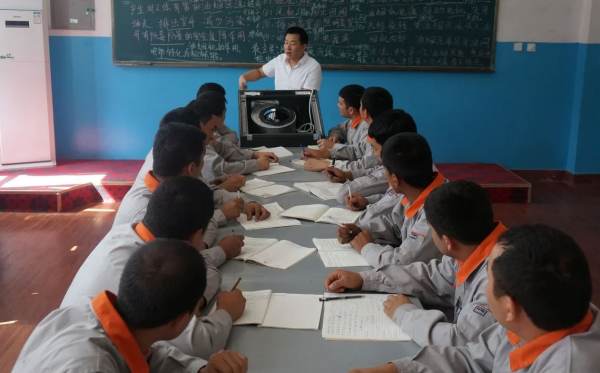 Moyu Camp China
Moyu Camp China
Classrooms full of soft, serene music. Young women and men sit at their desks. Mandarin banners read: ‘The more books you read, the more powerful you are’. Portraits of Albert Einstein and Asian scientists I do not recognize on the walls. Not a single smartphone in the students’ hands – it looks like a 20th Century school from the old movies.
TRENDING: WOW! Did Joe Biden Fall Asleep During Live Town Hall with Hillary Clinton? (VIDEO)
We are visiting the Moyu County Vocational Center, as it is called in our travel guides. Our guides, as well as the entire journey, are provided by the Chinese government. This means we are only able to visit places and speak to people they want. Our interpreters are also provided by the government. When I leave my hotel room, I am immediately confronted with a female chaperone who seems to be sitting outside my door 24/7, without eating or sleeping, but instead providing me three times a day with a meal fit for a king, or a Chinese Emperor.
Moyu County is one of approx. 99 counties of the Xinjiang Uyghur Autonomous Region (XUAR). Located West of Mongolia and North of Tibet, Xinjiang means “New Frontier” and has been part of China since the Qing Dynasty 1750. It is the only region of China where Muslims have been the majority for ages in this mostly atheist Communist country. Even now, more than 60% of the 23,600,000 XUAR population are ethnic minorities: Uyghur, Kazakh, Kyrgyz, Hui.
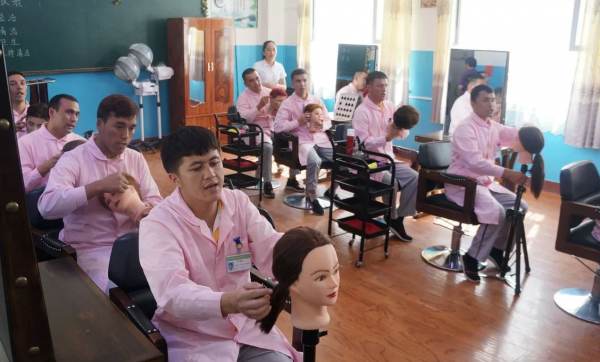
And it is the only place in the world where the worst practice of 20th Century totalitarianism rears its head again: Concentration Camps.
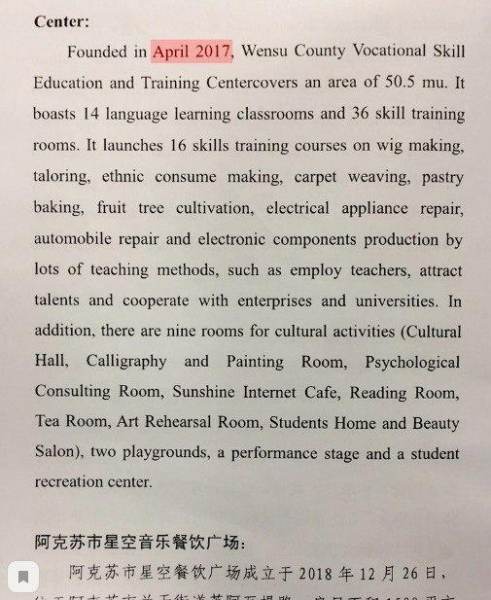
Western media are full of reports of “1 million Uyghurs detained in Chinese Concentration Camps. But what’s the real story? The witnesses are questionable, satellite photos are low-res, and Washington likes to trot out the Concentration Camp argument in each new wave of Chinese-American trade wars. So I wanted to see for myself.
Chinese officials do not deny the Camps’ existence — they just call them Vocational Training Centers. In July 2019, Chinese embassy press attachés invited journalists from 23 countries (including dozen of Muslim countries) on an all-expenses-paid junket to tour the camps and form their own opinion. In August of 2019, I visited Xinjiang with other journalists.
“I was invited to attend this camp after sharing ISIS propaganda!”
‘My name is Muhammad Ali, 22, I’m a peasant. I used to hate drinking alcohol, since it violated Sharia Law, and shared my views with my neighbors and friends. Someone reported me to the authorities, and so I was “invited” to appear before the Cadre Committee of the local government, where I was informed of the charges. I then agreed to apply to this school. I have been here for 8 months now, learning to be a qualified painter. My girlfriend is waiting for me at home.’
This is a typical Moyu Camp resident’s story. Most of the students (prisoners? inmates?) are young and male. No traditional Muslim caps, no smartphones, no Qurans or any other religious books on the bookshelves. ‘We believe in science now’, the guys with the Muslim-sounding names tell me.
There are no bars on the windows. The school is located in an urban area, and, according to our handlers, students are free to leave the Camp on weekends to visit their families.
Later, looking through my notes, I will remark that we visited the Moyu Camp on a weekend: Saturday, July 20, 2019. But all the classrooms were full.
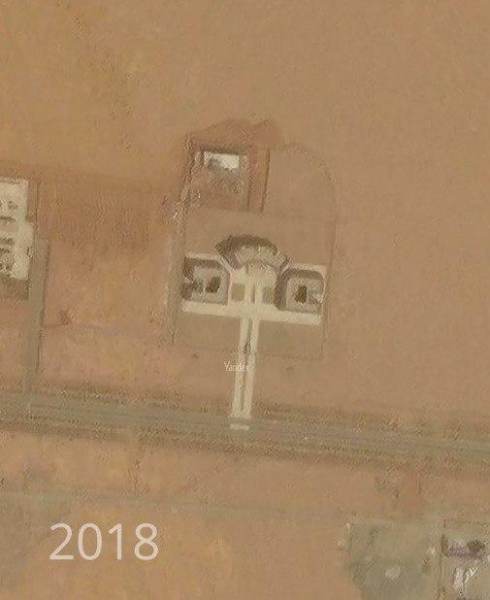 Aerial view of Wensu Concentration Camp in Western China
Aerial view of Wensu Concentration Camp in Western China
Most of the classrooms of this five-storey building are equipped with training equipment and machines: Agricultural class with greenhouse plants. Cooking class in a giant kitchen that could feed a battalion. Car shop. Electrical shop. Barbershop. Art class. Inmates’ paintings sell for 300 Yuans ($42.50) each.
‘Here, the students can learn a high-paying trade,’ the supervisors explain. ‘After graduating from this school, they can get a prestigious job, such as masseur, hotel cleaning staff, or auto mechanic — instead of succumbing to extremism.’
‘Our government supports individual and religious freedom, including traditional Islam,’ remarks our main handler Li Jie, XUAR State Information Office chief. ‘But freedom is impossible without limits. Say, you’re sleeping in a hotel at midnight, and somebody starts playing music in the hall. What do you do? Limit freedom to maintain order.’
Camp inmates have their freedom restricted for 8-12 months, for the duration of the ‘de-radicalization course’. Their stories are all similar:
‘I met a stranger on social media who started to discuss various aspects of Islam with me. He sent me extremist videos with ISIS propaganda. Then I was “invited” to appear before the Cadre Committee, where I voluntarily signed up to attend this school.’
Thanks to the Great Chinese Firewall, user activity on Chinese messengers and social networks is closely surveilled by the intelligence services. Like an anti-extremist antivirus scanner, this security scan compares your smartphone media files (even in peer-to-peer chats) with a library of tens of thousands of examples of inappropriate content. This is how the future inmates of Uyghur Camps are identified.
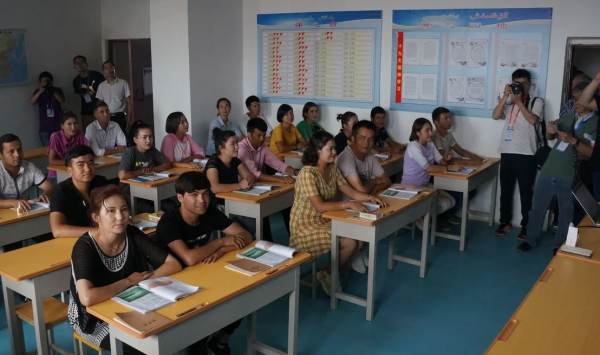
The happy deradicalized farmer
Rural countryside, 6 miles outside of Hotan — one of the cities of XUAR with the largest Uyghur populations. We meet the family who lives here: A husband and wife cradling a 4-year-old child in their arms — an ideal family from a TV commercial.
May name is Abdualali, son of Abdykadyr, I’m 25 years old. A year and a half ago, I started communicating with a stranger on (Chinese messenger) WeChat, who sent me extremist videos. I began to pray multiple times a day, prohibited my wife from leaving the house, and disrespected my parents. But thanks to the government’s patience, I was given the opportunity to see the error of my ways, and invited to attend the Training Center, where I’ve been for 8 months now…’
Some of our group of journalists are Central Asians. They try to speak with the young farmer in Uzbek or Kazakh (which are similar to the Uyghur language). Abdulali refuses, only interacting with us through the Chinese interpreter, obviously unwilling to try “the government’s patience.”
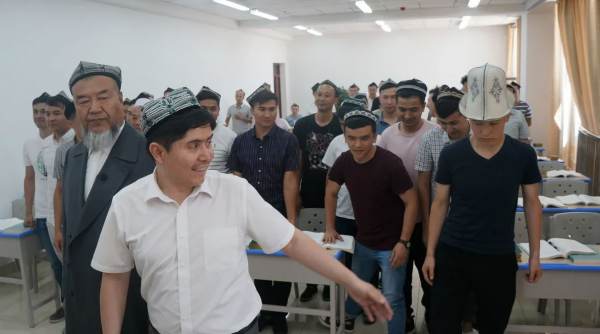
‘After graduating from the Training Center, I heard a new village was being built in Hotan county, where my agricultural skills would be in demand. To buy this house, the Government provided me 100,000 Yuan, and my parents gave me the rest, 50,000 Yuan. Our monthly family income is 4,000 Yuan ($560), my wife works at a nearby textile factory. I’m still a Muslim, but not an Islamist.’
We don’t see any cell phones in the deradicalized farmer’s house. No computer, no personal belongings, a few children’s toys and a family photo on the wall. There’s a TV set, a talk-show is on. ‘They are working hard all day and don’t need a computer, our handler explains.
Bars on the window: For Safety
Our journey is reaching its culmination. 25 miles of desert road, a lone group of three buildings surrounded by walls and sandy plains: Wensu County Vocational Training Center in the Aksu Prefecture, near Taklamakan Desert. This ‘training center’ is quite different from the others we visited.
According to my investigation, there are two types of XUAR Camps. The lite version is usually located in a city (like the Moyu Camp described above) — for the less extremist inmates who are more open to learning (let’s not get into whether all of them are really extremists).
And then there’s the maximum-security version: Prison-like buildings far from cities for those whose extremist inclinations the Communist Party judges to be truly dangerous.
These are the ones with bars on the windows.
Our delegation is led inside, into a hall with dozen of boys and girls. Without no introduction, they began ethnic dancing to Uyghur music. After a few minutes, they invite us to dance: Young men approach the female journalists, girls the men.
An Uyghur girl of about 18-20 years grabs my hand and wants to dance with me. I’m shocked by the awkward display. I see her smudged makeup and the fear in her eyes behind the forced smile.
This is how our hosts want to demonstrate how happy the inmates are.
“Before I came to this school, I was a Muslim. But now I’m not,” the girl tells me. I try to find out her name, but our interpreter has disappeared. Feeling quite the James Bond, I covertly geotag this place on my cell phone.
We are accompanied by Rebigul Ramtulla, the female director of Wensu Camp. She’s an Uyghur.
“The capacity of our institution is 500 inmates. We recently had a class graduate, so right now, the number is less: 214 boys and 103 girls,” Rebigul says.
“Why don’t they have cellphones?” I ask.
“They can distract from the educational process, “ she says.
“And why do you have bars on the windows?”
“For safety reasons,” Rebigul says. “The pupils wash the windows here, and the bars prevent them from falling.”
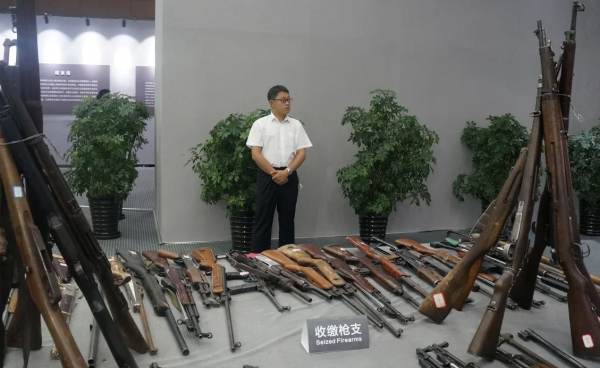 Firearms confiscated in Western China
Firearms confiscated in Western China
We tour the dorm rooms of the building: 10 perfectly-made beds in each, a few personal belongings, a shower in the corner.
Next, the classroom: The level of education here in Wensu is more elementary than in the low-security camps like Moyu. Many inhabitants of China”s ‘Wild West’ don’t speak Mandarin well, so there’s a lot of Chinese language classes, plus Chinese laws and physical education, plus very simple tasks like home econonmics, cooking, gardening and planting.
After the De-Radicalization Course, the inmates have to pass a De-Radicalization Test, a combination of written and oral exams with supervisors, in order to determine whether he or she has recovered from what Beijing calls ‘extremism.’ This means, whether to release an inmate or not is purely the call of their supervisors — but, as they assure me, ‘graduation rates’ are high and few students stay more than a year unless they voluntarily opt to obtain more high-level qualifications at a Vocational Center like Moyu.
I ask Directress Rebigul the key question, which no one has answered so far: ‘How many of these camps are there?’
‘I don’t know, I only know about my camp’, she says.
Later I will recall the Mayor of Moyu County, who accompanied us during the Moyu Camp visit, remarked: ‘Moyu County has only one such installation. XUAR has approximately 99 counties. So if each county has a similar 500-person capacity camp, the overall capacity might be about 50,000 inmates. The average duration of ‘De-Radicalization’ is 8-12 months. Therefore, roughly 200,000-250,000 inmates may have passed through the Camps since the werey established in 2015.
The Terror Museum
The Xinjang Terrorist Attack and Violent Crimes Exhibition occupies the area of two football fields. It is a memorial museum. Pyramids of rioters’ guns. Carpets of hand-made grenades. Dozens of edged weapons — from crossbows to butcher’s knives. Actual equipment seized from terrorists, enough to supply an Army division.
Plaques on the wall feature descriptions of each attack — with photos and subtitles:
In 2009, Mehsun Abdulkerim and Nurmamat Oblikasim, among others, started to spread religious extremism by illegally teaching the Quran at unregistered religious gatherings, forming a 21-member terrorist gang. On October 14, 2010, they beheaded Niyaz Abdulrexit, a teacher at the Tagarqi Middle School, and his wife, Nurela Abel in Shule County, because Abdulrexit taught children Darwin’s Evolution Theory.
Documentary photos on each display showing the victims of Islamist stabbings, shootings, car attacks and explosions. The photos are so graphic they are restricted for children and pregnant women.
After visiting this museum, I have to admit there may be some justification for the camps.
Once I get home, I pull up the geotag I made of Wensu Camp on my phone. (In China, a lot of foreign internet services, such as the maps app on my iPhone). I find the main building and two minor edifices beside it. The satellite photo is dated 2018. But where are the trees in the yard? Where is the sports field to the right? Where is the outdoor area to the left? Where are the main gates and all other details I remember?
In the 2018 satellite photo, Wensu Camp looks abandoned or unfinished. The Chinese brochure the handlers gave me claims: Wensu Skill Center was founded April 2017.
Was our whole junket a huge staged Potemkin village? Hard to know.
According to the CCP, since the Camps were established in 2015, there have been no new terrorist attacks in XUAR.
Edvard Chesnokov is a correspondent for Komsomolskaya Pravda, the largest Russian daily newspaper.

